小学英语教学调查报告
英语教学现状调查报告
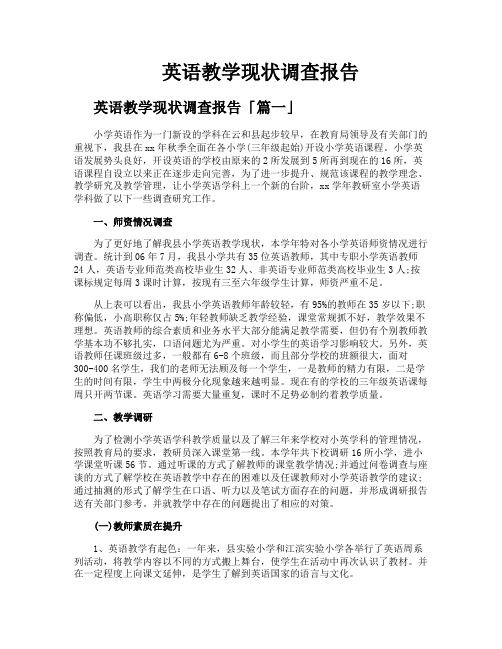
英语教学现状调查报告英语教学现状调查报告「篇一」小学英语作为一门新设的学科在云和县起步较早,在教育局领导及有关部门的重视下,我县在xx年秋季全面在各小学(三年级起始)开设小学英语课程。
小学英语发展势头良好,开设英语的学校由原来的2所发展到5所再到现在的16所,英语课程自设立以来正在逐步走向完善,为了进一步提升、规范该课程的教学理念、教学研究及教学管理,让小学英语学科上一个新的台阶,xx学年教研室小学英语学科做了以下一些调查研究工作。
一、师资情况调查为了更好地了解我县小学英语教学现状,本学年特对各小学英语师资情况进行调查。
统计到06年7月,我县小学共有35位英语教师,其中专职小学英语教师24人,英语专业师范类高校毕业生32人、非英语专业师范类高校毕业生3人;按课标规定每周3课时计算,按现有三至六年级学生计算,师资严重不足。
从上表可以看出,我县小学英语教师年龄较轻,有95%的教师在35岁以下;职称偏低,小高职称仅占5%;年轻教师缺乏教学经验,课堂常规抓不好,教学效果不理想。
英语教师的综合素质和业务水平大部分能满足教学需要,但仍有个别教师教学基本功不够扎实,口语问题尤为严重。
对小学生的英语学习影响较大。
另外,英语教师任课班级过多,一般都有6-8个班级,而且部分学校的班额很大,面对300-400名学生,我们的老师无法顾及每一个学生,一是教师的精力有限,二是学生的时间有限,学生中两极分化现象越来越明显。
现在有的学校的三年级英语课每周只开两节课。
英语学习需要大量重复,课时不足势必制约着教学质量。
二、教学调研为了检测小学英语学科教学质量以及了解三年来学校对小英学科的管理情况,按照教育局的要求,教研员深入课堂第一线。
本学年共下校调研16所小学,进小学课堂听课56节。
通过听课的方式了解教师的课堂教学情况;并通过问卷调查与座谈的方式了解学校在英语教学中存在的困难以及任课教师对小学英语教学的建议;通过抽测的形式了解学生在口语、听力以及笔试方面存在的问题,并形成调研报告送有关部门参考。
小学英语教学的调查报告
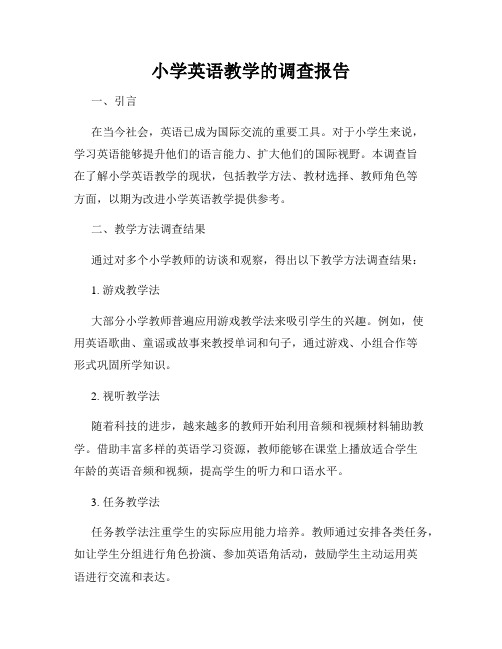
小学英语教学的调查报告一、引言在当今社会,英语已成为国际交流的重要工具。
对于小学生来说,学习英语能够提升他们的语言能力、扩大他们的国际视野。
本调查旨在了解小学英语教学的现状,包括教学方法、教材选择、教师角色等方面,以期为改进小学英语教学提供参考。
二、教学方法调查结果通过对多个小学教师的访谈和观察,得出以下教学方法调查结果:1. 游戏教学法大部分小学教师普遍应用游戏教学法来吸引学生的兴趣。
例如,使用英语歌曲、童谣或故事来教授单词和句子,通过游戏、小组合作等形式巩固所学知识。
2. 视听教学法随着科技的进步,越来越多的教师开始利用音频和视频材料辅助教学。
借助丰富多样的英语学习资源,教师能够在课堂上播放适合学生年龄的英语音频和视频,提高学生的听力和口语水平。
3. 任务教学法任务教学法注重学生的实际应用能力培养。
教师通过安排各类任务,如让学生分组进行角色扮演、参加英语角活动,鼓励学生主动运用英语进行交流和表达。
三、教材选择调查结果针对教材选择,我们对多所小学的英语教师进行了调查,并整理出以下结果:1. 使用教材的情况绝大部分小学英语教师使用统一的教材编写的英语教材,这有助于保持教学的连贯性和统一性。
同时,一些教师还会搜集和编写一些与学生年龄和兴趣相符的教材。
2. 教材内容的评价教师们认为好的教材应该既符合学生的年龄特点,又有趣味性和实用性。
他们希望教材内容能通过与学生生活和经验相关的材料,激发学生的学习兴趣和动力。
四、教师角色调查结果通过针对小学英语教师的观察和问卷调查,我们整理出以下教师角色调查结果:1. 指导者小学英语教师起到指导学生学习的重要角色。
他们负责为学生创设学习环境,制定学习活动和任务,引导学生形成正确的学习方法和学习策略。
2. 引导者教师在课堂上应起到引导学生主动参与学习的角色。
通过鼓励学生提问、互动交流、小组活动等方式,激发学生的学习兴趣,并培养他们自主学习的能力。
3. 评价者教师应及时对学生的学习进行评价和反馈。
(完整版)小学生英语学习现状调查与分析报告
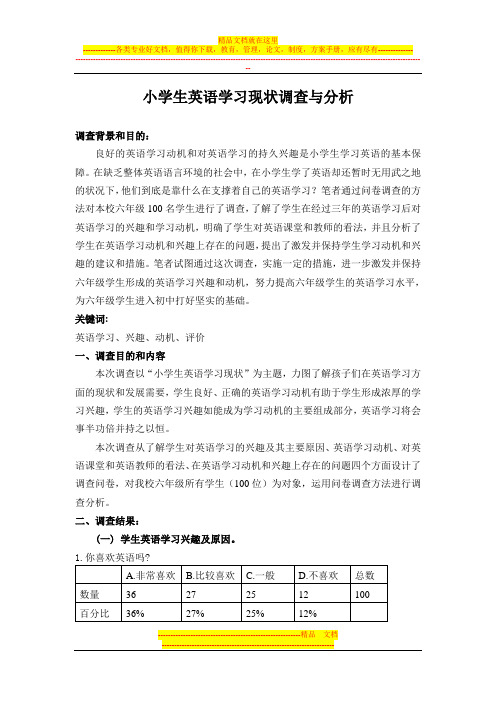
小学生英语学习现状调查与分析调查背景和目的:良好的英语学习动机和对英语学习的持久兴趣是小学生学习英语的基本保障。
在缺乏整体英语语言环境的社会中,在小学生学了英语却还暂时无用武之地的状况下,他们到底是靠什么在支撑着自己的英语学习?笔者通过问卷调查的方法对本校六年级100名学生进行了调查,了解了学生在经过三年的英语学习后对英语学习的兴趣和学习动机,明确了学生对英语课堂和教师的看法,并且分析了学生在英语学习动机和兴趣上存在的问题,提出了激发并保持学生学习动机和兴趣的建议和措施。
笔者试图通过这次调查,实施一定的措施,进一步激发并保持六年级学生形成的英语学习兴趣和动机,努力提高六年级学生的英语学习水平,为六年级学生进入初中打好坚实的基础。
关键词:英语学习、兴趣、动机、评价一、调查目的和内容本次调查以“小学生英语学习现状”为主题,力图了解孩子们在英语学习方面的现状和发展需要,学生良好、正确的英语学习动机有助于学生形成浓厚的学习兴趣,学生的英语学习兴趣如能成为学习动机的主要组成部分,英语学习将会事半功倍并持之以恒。
本次调查从了解学生对英语学习的兴趣及其主要原因、英语学习动机、对英语课堂和英语教师的看法、在英语学习动机和兴趣上存在的问题四个方面设计了调查问卷,对我校六年级所有学生(100位)为对象,运用问卷调查方法进行调查分析。
二、调查结果:(一) 学生英语学习兴趣及原因。
1.你喜欢英语吗?选择A和B的学生有52%认为英语很有用;47%认为英语或者英语课有趣。
选择C和D的学生45%认为英语或者英语课不生动,学起来很无趣;54%的学生觉得学习英语难度大。
上表说明,大部分学生对英语抱有浓厚的学习兴趣,学生喜欢英语的主要原因是觉得英语或英语课有趣,另一重要原因是认为英语很有用。
对英语不感兴趣的学生一方面主要是因为不太喜欢英语或英语课,另一方面是觉得英语难度大。
上表说明了教师的个人魅力对于学生学习兴趣起到很大的影响作用。
小学英语情境教学问卷调查分析报告范文

小学英语情境教学问卷调查分析报告范文全文共6篇示例,供读者参考篇1My Report on the English Situational Teaching SurveyIntroductionHello, my name is Amy and I'm a student in Primary 5. Our English teacher, Miss Lee, recently conducted a survey about Situational Teaching in our English lessons. She wanted to find out what we students thought about learning English through different situations and activities. I'm going to share the results of the survey and my thoughts on it.The SurveyThe survey had 10 questions and all of us in Primary 4 to 6 had to answer it. The questions were about the different situations and activities Miss Lee uses to teach us English. Some examples are role-playing, games, singing songs, and watching videos. We had to rate how much we enjoyed each activity and if we felt it helped us learn English better.Survey ResultsHere are the main findings from the survey:Role-playing was the most popular activity, with 85% of students saying they really enjoyed it and found it very helpful for learning English.Games like bingo, charades and treasure hunts came a close second, with 80% of students giving them a thumbs up.Singing songs and watching videos were also quite popular, appreciated by around 70% of students.The least popular were reading dialogues from the textbook (only 30% liked it) and writing exercises (40% enjoyed them).An overwhelming 92% of students said they learned English better through situational activities compared to just reading from textbooks and doing worksheets.My Thoughts on the ResultsI definitely agree with the survey results! Role-playing is my absolute favorite way to learn English. It's really fun to pretend to be different characters and act out scenes. Like if we're learning about going to the supermarket, we get to role-play as shoppers and shopkeepers. This makes it so much easier to remember the new words and expressions.Games are great too because they make learning English an enjoyable challenge instead of hard work. For example, when we play English Bingo or Charades, we're practicing vocabulary and phrases without even realizing it. The competitiveness also motivates us to do better.Singing songs helps a lot with pronunciation and remembering lyrics is a cool way to learn new sentence structures. The videos are engaging and give real-life examples of how English conversations happen.I'm not a big fan of just reading dialogues because they can be quite boring after a while. The writing exercises are ok but quite hard, especially if we have to write a lot.So overall, I really enjoy the interactive and hands-on nature of situational teaching. It makes English lessons way more fun and interesting compared to just doing textbook work. I feel like I learn better this way too because the situations stick in my mind much more than just reading something.Room for ImprovementAlthough most of us love situational teaching, the survey showed that some students still find it a bit difficult or embarrassing at times. A few said they get nervous acting outroles in front of others. Some also requested more technology like learning English through apps and online games.So I think Miss Lee could look into having more pair/group activities instead of just whole-class ones. That might make the shy students feel more comfortable. Using more digital tools could make lessons even more engaging too.But on the whole, the positive response to the survey proves that situational teaching is a big hit! I really hope Miss Lee and our other English teachers continue using lots of fun activities, games and role-plays to make learning English an awesome experience.ConclusionTo sum up, this survey has shown that us primary school students overwhelmingly prefer learning English through situations and interactive activities rather than just textbooks and worksheets. Methods like role-playing, games, songs and videos seem to be the most effective and enjoyable ways to pick up the language.While there's still some room for improvement, situational teaching is clearly the way to go for making English lessons engaging and helping us become more confident andcompetent English speakers. Thanks for reading my report! I'm off to prepare for an English TV news reporting role-play now. Goodbye!篇2Here's a sample 2000-word report analyzing a survey on situational English teaching in primary schools, written from a primary student's perspective:Title: Fun Ways to Learn English at SchoolIntroductionHi there! My name is Emma, and I'm a student in Year 5. Our teacher, Miss Wong, recently gave us a survey about how we like to learn English in class. She wanted to find out what kinds of activities we enjoy the most and which ones help us understand better. After we all filled out the survey, she shared the results with us. It was really interesting to see what my classmates thought! Here's what we found out:Survey ResultsMost of us said that we like it when English lessons are fun and interactive. The activities we enjoyed the most were:Role-playing/Acting out dialogues and stories (87%)Singing songs and chanting rhymes/raps (84%)Watching short video clips or movies (81%)Playing educational games (79%)A lot of us also said that we find it easier to learn new words and grammar when we can connect them to real-life situations. For example, over 70% of us felt that using props, realia (real objects), and pictures/flashcards helped us remember vocabulary better.On the other hand, some of the activities we didn't find as engaging were just reading from our textbooks (23% enjoyed this), doing written exercises from worksheets (31%), and listening to the teacher explain grammar rules (39%).AnalysisFrom the survey, it's clear that us kids really respond well to active, hands-on learning. When we get to do role-plays, sing songs, watch videos etc., it makes the lessons much more fun and memorable. I think it's because we're using English in a realistic way, just like how we'd use it in the real world. Instead of just reading about how to order food at a restaurant, we can actually act it out. That makes it easier for the language to stick in our minds.The use of props, pictures and real objects also seems to help a lot of us. I guess it's because we're visual learners, and having something concrete to look at helps connect the words to their meanings. Just reading vocabulary lists can be boring, but if we can see and touch the objects, it makes more sense.While we don't dislike reading, writing, and analyzing grammar completely, most of us find those solo activities a bit dry if that's all we're doing. From the results, it looks like we learn best when we can experience English through multi-sensory methods – speaking, listening, moving around, etc. That's probably why games, role-plays and songs ranked so highly.RecommendationsBased on the survey results, I think there are a few ways our teachers could make English lessons even more engaging:Have more conversational practice through role-plays, games and group activities. We could set up class "restaurants", "shops" etc. and take turns being customers and servers.Use more audio-visual materials like short video clips, songs/rhymes, and flashcard games. The songs seem to really help us remember vocab and grammar.Go on field trips or bring in guest speakers sometimes. It would be cool to practice our English with native speakers or in real-life environments like restaurants.Use more hands-on props and realia, especially for new vocabulary topics. Let us touch and play with the objects while learning the words.For grammar study, try to make it more interactive with games, dialogues and role-plays instead of just lecturing rules.Overall, the survey showed that when English is taught through engaging, multi-sensory activities, it really helps us learn better and have more fun!ConclusionWell, that's my report on our class survey results! I hope our teachers find the feedback useful. At the end of the day, we're just kids - and kids learn best when lessons are interactive, hands-on and enjoyable. With some fun new additions to our English programme, I'm sure we'll make great progress. Let me know if you have any other questions!篇3Situational English Teaching in Primary Schools: A Student's PerspectiveIntroductionLearning English as a second language can be a daunting task for many primary school students, especially when it comes to understanding and applying the language in real-life situations. Traditional teaching methods often focus on rote memorization of grammar rules and vocabulary, which can be dry and demotivating for young learners. Fortunately, many schools have embraced a more innovative approach called "situational English teaching," which aims to create immersive and engaging environments for students to practice English in contexts that mimic real-life scenarios.As a primary school student who has experienced both traditional and situational English teaching methods, I would like to share my insights and perspectives on this approach. In this report, I will explore the benefits and challenges of situational English teaching, as well as provide recommendations for further improvement.Benefits of Situational English TeachingIncreased Engagement and MotivationOne of the most significant advantages of situational English teaching is its篇4My Big Report on How We Learn English at SchoolIntroductionHi there! My name is Amy and I'm a 5th grader at Sunnydale Elementary. Our school has been trying out some new ways of teaching us English and they asked me and my classmates to let them know what we think by filling out a survey. Well, I really had a lot to say! English is one of my favorite subjects but learning it can be pretty confusing and frustrating sometimes. I decided to put together this big report to share my thoughts and the results from the survey.The Old Way of Learning EnglishUp until last year, we learned English pretty much just by listening to our teacher explain grammar rules and doing worksheets or activities from our textbooks. I have to admit, it was kind of boring! Just sitting at our desks going through the books page by page. We did get chances to practice speaking English with our classmates sometimes, but it always felt reallyawkward and unnatural. Like we were just reciting from a script instead of actually using the language to communicate.About half the kids in my class, including me, come from homes where our parents don't really speak much English. So we didn't get a whole lot of English practice outside of school either. By the time I got to 4th grade, even though we had been studying English for years, I still didn't feel very confident using it.I could get decent grades on tests about vocabulary and grammar, but I had a really hard time understanding English movies or books, or just basic conversations.The New Situational Teaching MethodThat's when our school decided to try this new "situational" method for teaching English. Instead of just lectures and textbook exercises, our teachers started creating more realistic scenarios and activities to get us practicing English in a more natural way.For example, one week our classroom was turned into a little restaurant. Some kids were the servers, some were the cooks, some were the customers. We had to use English to take orders, call out the food from the kitchen, pay the bill, and interact just like you would at a real restaurant. Another time, we had a little store set up and half the class were the shopkeepers sellingdifferent items while the other students were the customers coming in to shop, make purchases, and have English conversations.We even went on some field trips around town and had to use our English to ask directions, make requests at places like cafes or shops, and discuss what we were seeing and doing. One of my favorite activities was putting on a short play entirely in English for our parents and the other classes at school.What We Thought About Situational TeachingOur teachers had us all fill out a survey to get our feedback on this new situational approach compared to how we learned English before. I thought the survey questions were really on point and managed to cover all the key things I wanted to give my opinion on.First, we were asked whether the new teaching method helped improve our overall English ability like speaking, listening, writing etc. An overwhelming 87% of students, including me, said we felt our English got much better across all areas compared to just doing textbook work. Putting the language into real practice and not just doing grammar drills made such a big difference!We were also asked if the new method was more enjoyable and engaging than our previous English classes. A massive 94% of us said it was way more fun and interesting! Speaking for myself, I actually looked forward to English class and didn't dread it like I used to. The activities were exciting, kept us on our toes, and made learning English feel like a fun challenge rather than a boring chore.Another key question was whether the new situational method made us feel more motivated and confident to use English, even outside of class. 79% of us, myself included, said we did feel way more motivated to practice and confident trying to use English in the real world after doing all those realistic practice activities at school. I know I personally started feeling way less shy about trying to strike up English conversations when I was out and about.The survey also asked about whether we felt the situational teaching was more effective at preparing us for tests, speaking with foreigners, watching English movies, reading English books etc. An impressive 92% of students agreed it gave us way better real-world skills that transfer over to all those English language domains compared to just textbook learning. I know I went from struggling to follow even simple English videos to now beingable to comprehend most stuff for kids my age without too much trouble.Concluding ThoughtsTo wrap up my report, I want to say that overall, our class massively prefers and benefits way more from this new situational way of learning English. Getting immersed in real篇5Here's a 2000-word sample analysis report written from a primary school student's perspective on the topic of "Situational English Language Teaching Survey and Analysis Report":Situational English Language Teaching Survey and Analysis ReportIntroductionEnglish is one of the most important languages in the world. It's spoken by people from different countries and cultures, and it's really helpful for communicating with others. In our school, we learn English through situational teaching methods, which means our teachers try to create real-life situations in the classroom to help us understand and use English better.Our class recently conducted a survey to find out how effective these situational teaching methods are in helping us learn English. We wanted to know what kinds of activities and techniques our classmates find most helpful, and what areas could be improved. In this report, I'll share the results of our survey and provide an analysis of what we've learned.Survey MethodologyWe created a simple questionnaire with ten questions about our experiences with situational English language teaching. The questions covered topics like:Types of situational activities we do in class (role-playing, games, etc.)How helpful we find these activities for learning vocabulary, grammar, and conversation skillsWhether we feel more confident speaking English after participating in situational activitiesWhat we like or dislike about situational teaching methodsSuggestions for improving or adding new situational activitiesWe handed out the questionnaires to all 30 students in our class, and 28 of them completed and returned the survey.Survey ResultsHere are some of the key findings from our survey:The most popular situational activities were role-playing scenarios (89% of students found them helpful), vocabulary games (86%), and conversation simulations (82%).Students felt that situational activities were most effective for improving their speaking skills (93% said they helped "a lot" or "somewhat") and vocabulary acquisition (86%).However, only 68% of students felt that situational activities helped them improve their grammar skills, which was the lowest rating among the language areas we asked about.Overall, 82% of students said they felt more confident speaking English after participating in situational activities.The things students liked most about situational teaching were that it made learning fun (96%), helped them practice real-life conversations (89%), and made it easier to remember new words and phrases (86%).Some of the dislikes or areas for improvement included: not having enough opportunities to practice (21%), feeling shy or nervous in front of classmates (18%), and finding some activities too difficult or confusing (11%).Analysis and RecommendationsBased on the survey results, it's clear that situational teaching methods are generally well-received and effective for helping us learn English, particularly when it comes to improving our speaking skills and vocabulary. The interactive and real-life nature of these activities makes learning more engaging and memorable, which is reflected in the high ratings for boosting confidence and making learning fun.However, the results also suggest that there's room for improvement, especially when it comes to teaching grammar concepts through situational methods. While role-playing and conversation simulations are great for practicing fluency and vocabulary, they may not provide enough explicit instruction or structured practice for mastering complex grammar rules.To address this, our teachers could consider incorporating more grammar-focused activities or mini-lessons within situational scenarios. For example, they could highlight specific grammar points during role-plays and provide feedback andcorrections. They could also create situational games or tasks that require us to use particular grammar structures accurately.Another area for improvement is providing more opportunities for individual practice and ensuring that activities are appropriately challenging without being too difficult or confusing. Some students felt shy or nervous performing in front of classmates, so teachers could consider breaking us into smaller groups or pairs more often, or providing low-stakes opportunities to practice before presenting to the whole class.Overall, though, the survey results indicate that situational teaching methods are an effective and popular way to learn English in our class. By continuing to use these interactive and engaging activities, while also addressing areas for improvement like grammar instruction and individual practice opportunities, our teachers can help us become even more confident and proficient English speakers.ConclusionLearning a new language can be challenging, but situational teaching methods make the process more fun and relatable. Through this survey, we've gained valuable insights into what works well and what could be improved in our situational English lessons.By incorporating more grammar-focused activities, providing more individual practice opportunities, and ensuring that activities are appropriately challenging, our teachers can continue to enhance our learning experience and help us become even better English communicators.I'm grateful to have had the opportunity to conduct this survey and share our findings. It's been a great learning experience for me, and I hope our recommendations will be helpful in shaping the future of situational English teaching in our class and school.篇6A Big Look at How We Learn English in Fun WaysIntroductionHi everyone! My name is Emma and I'm a 5th grader at Oakwood Elementary School. For our class project this year, we did a big survey about how we learn English through fun activities and real-life situations instead of just from textbooks. Our teacher says this is called "situational" or "contextual" learning. We asked other students, teachers, and even some parents about what they think are the best ways to practice English in a natural way. Here's what we found out!Survey MethodsFirst, we made a survey with 10 questions to ask people's opinions on things like role-playing, games, show&tell, field trips, and other interactive English activities. We asked multiple choice, rating scale, and open-ended questions. For example:"How much did you enjoy the restaurant role-play activity?"(Rating scale from 1-5 smiling faces)"What was your favorite kind of situational learning activity and why?"(Open-ended response)We had 125 student surveyors who went around during lunch, recess, and after school to get responses from:375 students (from grades 1-5)32 teachers67 parentsWe put everything into a spreadsheet to analyze the data. It took a while but it was cool to see all the numbers and figures!Key FindingsAlmost everyone agreed that contextual, engaging activities are much more fun than just doing bookwork and drills. They make learning English feel realistic and useful, not just lessons. The top 3 favorite activities were:Field trips & community interactions (like restaurantrole-plays)Show&tell presentationsGames (board/card games, online games, etc.)Tied for 4th were drama/role-playing and creative projects like poster making. Least favorite was just having conversations without a clear context. Here's a breakdown of how much students said they enjoyed each activity type:Field trips/community visits: 89% loved itShow&tell: 81% loved itGames: 77% loved itDrama/role-play: 69% loved itCreative projects: 69% loved itOpen conversations: 43% loved itI put together some graphs that really show how much we all liked the contextual stuff. Check them out below! There are pie charts for overall feelings and bar graphs comparing how students, teachers, and parents rated each activity.In the comments, people explained why contextual learning is awesome. A few examples:"I loved the restaurant activity because it felt like actually ordering food, not just saying phrases from a book.""Field trips make the English so much more meaningful when you can use it right then and there.""The creativity in games and projects sparks way more interest than just memorizing.""It's so powerful for students to present and get thatreal-world practice in a supportive way."Some suggested even more ideas like job shadowing, mock debates, simulated business meetings, and culturalactivities/festivals.ConclusionOverall, the survey results proved that contextual, engaging, and interactive methods are a huge hit for learning English.Getting out of the classroom, roleplaying, creating projects, and any activities that feel relevant and lifelike make students way more motivated and interested. The feedback showed we crave authentic opportunities to use English in a natural way, not just from a textbook.I hope teachers keep using these awesome hands-on techniques. Situational learning makes English feel so much more alive and useful. It's the best way for kids like me to build confidence and skills we'll actually use when communicating and being global citizens. English opens up so many doors, so we've got to practice it in realistic situations that show its real power. That's the key takeaway from our school community's big survey! Let's get situational!。
小学英语教学调查报告
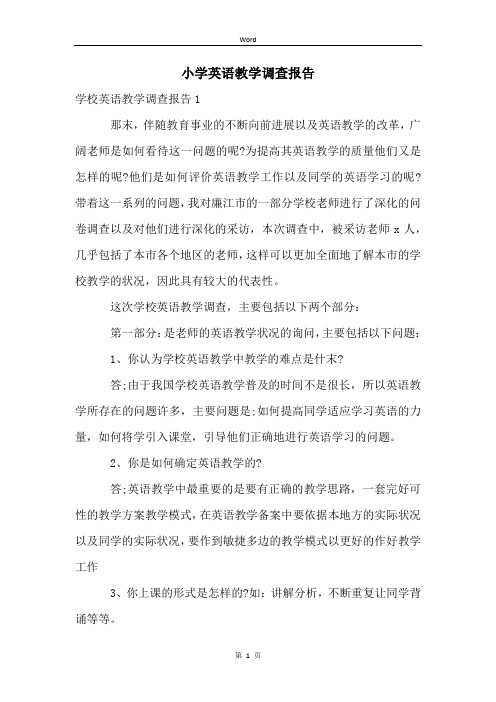
小学英语教学调查报告学校英语教学调查报告1那末,伴随教育事业的不断向前进展以及英语教学的改革,广阔老师是如何看待这一问题的呢?为提高其英语教学的质量他们又是怎样的呢?他们是如何评价英语教学工作以及同学的英语学习的呢?带着这一系列的问题,我对廉江市的一部分学校老师进行了深化的问卷调查以及对他们进行深化的采访,本次调查中,被采访老师x人,几乎包括了本市各个地区的老师,这样可以更加全面地了解本市的学校教学的状况,因此具有较大的代表性。
这次学校英语教学调查,主要包括以下两个部分:第一部分:是老师的英语教学状况的询问,主要包括以下问题: 1、你认为学校英语教学中教学的难点是什末?答;由于我国学校英语教学普及的时间不是很长,所以英语教学所存在的问题许多,主要问题是;如何提高同学适应学习英语的力量,如何将学引入课堂,引导他们正确地进行英语学习的问题。
2、你是如何确定英语教学的?答;英语教学中最重要的是要有正确的教学思路,一套完好可性的教学方案教学模式,在英语教学备案中要依据本地方的实际状况以及同学的实际状况,要作到敏捷多边的教学模式以更好的作好教学工作3、你上课的形式是怎样的?如:讲解分析,不断重复让同学背诵等等。
答:在讲解分析的同时让同学多背书并且制造更多的语音环境让同学不断提高口语水平4、在教学中,你是怎样处理教材挨次以及教材内容的?答;由浅及深,作到让同学更简单地接受英语学习,不肯定按步照搬地顺着教科书的内容进行上课5、老师是否注意教学的语言输入量,课堂教学的语言输入量是否充实呢?答:教学的语言输入量要作到适可而止,而且我的教堂上语言是比较充实的同时也比较敏捷,为的是让更多的空间给同学进行互相互动以及师生互动6、你认为英语教学还应当加强哪一方面的内容(或削减哪一方面的内容)?答,学校英语教学是对同学英语学习的启蒙,因此要加强同学的简洁的口语学习,尽量削减那些比较冗杂的语句以及语法教学7、你的教学内容设计是否具有规律性?答;我的教学内容设计是比较有规律性的,但是也会在教堂上依据实际状况进行相应的调整8、语言操练的密度。
小学英语学习状况研究报告

小学英语学习状况研究报告
研究背景
英语作为一门国际通用语言,在小学阶段的研究非常重要。
本研究旨在调查小学生英语研究的状况,为改进英语教育提供参考。
研究方法
我们采用问卷调查的方式收集了小学生英语研究的相关数据。
调查对象为不同年级的小学生,包括他们的研究兴趣、研究时间、研究方法等方面的信息。
研究结果
根据我们的调查结果,以下是小学生英语研究的状况总结:
- 研究兴趣:大部分小学生对英语研究表现出一定的兴趣,但也有一部分学生对研究缺乏积极性。
- 研究时间:绝大多数小学生每周都有专门的英语研究时间,但有一些学生的研究时间较为有限。
- 研究方法:大部分小学生采用课堂教学和课后复相结合的研究方法,但也有一些学生依赖于家庭教育资源。
结论
基于以上研究结果,我们得出以下结论:
- 鼓励小学生对英语研究保持兴趣,可以通过丰富的教学内容和趣味性的教学方法来激发学生的研究兴趣。
- 对于研究时间有限的学生,可以考虑在课堂上增加英语研究的时间,或者提供额外的研究资源和辅导。
- 家庭教育资源对于英语研究的辅助作用不可忽视,可以鼓励家长与学校合作,提供更多的英语研究支持。
建议
根据以上结论,我们提出以下建议:
- 学校应该设计富有趣味性的英语教学内容,激发学生的研究兴趣。
- 学校可以在课程安排中增加英语研究的时间,确保每个学生都有足够的时间进行研究。
- 学校和家长可以加强合作,共同为学生提供更多的英语研究资源和辅导。
以上是我们对小学英语研究状况的研究报告,希望能对改进英语教育有所帮助。
农村小学英语教学现状调查报告
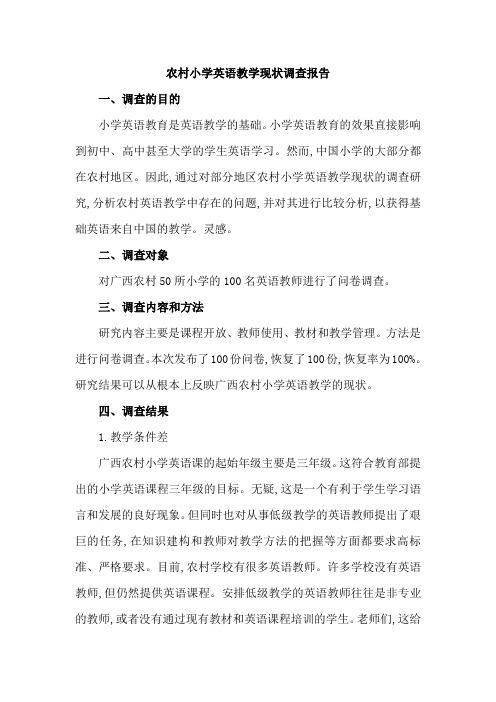
农村小学英语教学现状调查报告一、调查的目的小学英语教育是英语教学的基础。
小学英语教育的效果直接影响到初中、高中甚至大学的学生英语学习。
然而,中国小学的大部分都在农村地区。
因此,通过对部分地区农村小学英语教学现状的调查研究,分析农村英语教学中存在的问题,并对其进行比较分析,以获得基础英语来自中国的教学。
灵感。
二、调查对象对广西农村50所小学的100名英语教师进行了问卷调查。
三、调查内容和方法研究内容主要是课程开放、教师使用、教材和教学管理。
方法是进行问卷调查。
本次发布了100份问卷,恢复了100份,恢复率为100%。
研究结果可以从根本上反映广西农村小学英语教学的现状。
四、调查结果1.教学条件差广西农村小学英语课的起始年级主要是三年级。
这符合教育部提出的小学英语课程三年级的目标。
无疑,这是一个有利于学生学习语言和发展的良好现象。
但同时也对从事低级教学的英语教师提出了艰巨的任务,在知识建构和教师对教学方法的把握等方面都要求高标准、严格要求。
目前,农村学校有很多英语教师。
许多学校没有英语教师,但仍然提供英语课程。
安排低级教学的英语教师往往是非专业的教师,或者没有通过现有教材和英语课程培训的学生。
老师们,这给那些新外语的学生带来了巨大的阻力,为他们的演讲打下了良好的基础,培养了对学习的持久兴趣。
此外,农村学校的财政实力不足。
一般而言,公立学校的收入结构是政府补助金、学费、杂项费用、创收和社会捐赠。
政府补助金包括日常开支的人员和供应资金。
农村地区教师工资不能按时支付,直接制约了教师的教学积极性,制约了教学设备的购置和使用。
2.班级不足,间隔时间长小学英语班的班级少,大多数学校每周有两节课,几所学校每周有三班。
这样,每40到30天的英语课在每三到四天,基本上就没有语言交流的环境,结果就是忘记放学前后。
我市农村小学90%以上的学校有两个部分。
小学英语自学的时间严重不足。
接受调查的教师普遍表示,学校对此没有给予足够的重视,支持不足。
小学英语教育教学调查报告(精选7篇)
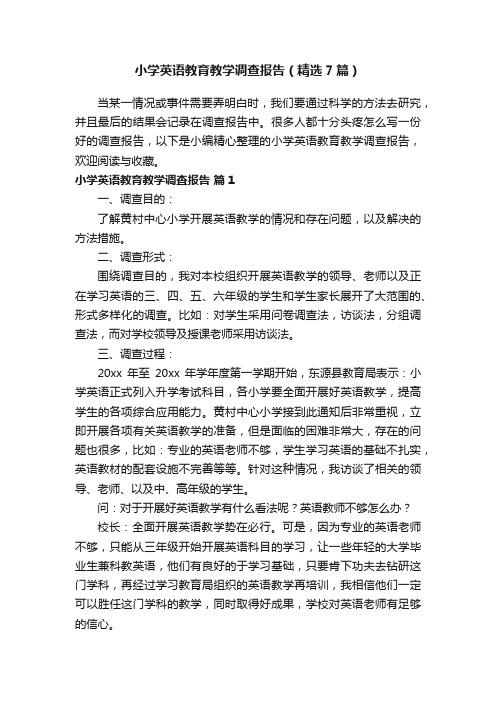
小学英语教育教学调查报告(精选7篇)当某一情况或事件需要弄明白时,我们要通过科学的方法去研究,并且最后的结果会记录在调查报告中。
很多人都十分头疼怎么写一份好的调查报告,以下是小编精心整理的小学英语教育教学调查报告,欢迎阅读与收藏。
小学英语教育教学调查报告篇1一、调查目的:了解黄村中心小学开展英语教学的情况和存在问题,以及解决的方法措施。
二、调查形式:围绕调查目的,我对本校组织开展英语教学的领导、老师以及正在学习英语的三、四、五、六年级的学生和学生家长展开了大范围的、形式多样化的调查。
比如:对学生采用问卷调查法,访谈法,分组调查法,而对学校领导及授课老师采用访谈法。
三、调查过程:20xx年至20xx年学年度第一学期开始,东源县教育局表示:小学英语正式列入升学考试科目,各小学要全面开展好英语教学,提高学生的各项综合应用能力。
黄村中心小学接到此通知后非常重视,立即开展各项有关英语教学的准备,但是面临的困难非常大,存在的问题也很多,比如:专业的英语老师不够,学生学习英语的基础不扎实,英语教材的配套设施不完善等等。
针对这种情况,我访谈了相关的领导、老师、以及中、高年级的学生。
问:对于开展好英语教学有什么看法呢?英语教师不够怎么办?校长:全面开展英语教学势在必行。
可是,因为专业的英语老师不够,只能从三年级开始开展英语科目的学习,让一些年轻的大学毕业生兼科教英语,他们有良好的于学习基础,只要肯下功夫去钻研这门学科,再经过学习教育局组织的英语教学再培训,我相信他们一定可以胜任这门学科的教学,同时取得好成果,学校对英语老师有足够的信心。
问:学校如何解决英语教学配套设施不足的问题呢?主任:要很好地开展英语教学,必须具备各种相应的教具和学具。
现在我们仅仅只有课本和录音带,因此要上好英语课并不容易啊!但是学校会尽最大的能力解决好这个问题,让每位英语教师拥有最好的条件去开展教学。
校长:学校会请相关的英语教师亲自去购买与教材相应的学习资料,从而方便英语教学的开展,学校也会给每一位英语老师配备教学助讲器,让他们轻松教学。
- 1、下载文档前请自行甄别文档内容的完整性,平台不提供额外的编辑、内容补充、找答案等附加服务。
- 2、"仅部分预览"的文档,不可在线预览部分如存在完整性等问题,可反馈申请退款(可完整预览的文档不适用该条件!)。
- 3、如文档侵犯您的权益,请联系客服反馈,我们会尽快为您处理(人工客服工作时间:9:00-18:30)。
小学英语教学调查报告
今年暑期,我系开展了三下乡活动,此次活动的目的是为了解社会对二十一世纪的建设人才提出了新的要求,小学英语因此也提到了日程上来。
由于大部分地区均为首次开设小学英语课程,处于摸索阶段。
许多关于如何开展英语课程问题困绕了着教育工作者。
小学生为这次变革的主体又是怎样看待英语课的呢?他们心目中的英语课堂又是怎样的呢?对此,我们开展了关于小学英语教学的问卷调查,经过具体汇总,共收集有效问卷90份,结果显示如下:
喜欢上英语课的学生占75%,持无所谓态度的占15%,害怕上英语课的占10%。
另外,在英语课堂上,遇到不会的问题愿意主动向老师提问的占45%,不确定会主动向老师提问的占25%,不会主动向老师提问的占30%。
此外,认识到英语对他们的重要性的占80%,认为学习英语对他们毫无作用的仅占20%。
最后一项调查主要是针对小学英语课开设情况的调查,结果显示,85%的学生认为英语课开设正常。
经过不同成绩水平、来自不同学校、不同家庭背景几个不同层次的学生代表的谈话以及与班主任的交流,同时也结合本人亲身观察,不难发现,大部分学生害怕老师提问,不敢开口,导致课堂气氛沉闷的原因有:一、对英语不感兴趣二、不喜欢英语老师三、确实不知道答案四、知道答案,但不知道如何用英语表达五、和班上同学不熟,害怕回答错误,被同学嘲笑。
其中我们了解到对上英语课持无所谓态度的主要原因是感觉课堂氛围不活跃,老师教学方式很老套。
对此,我们小组一致认为活跃课堂气氛是提高英语水平的关键因素。
通过与学生的交流我们还得知,部分学生本身原来基础就比较弱,而课程内容
逐步加深,无法接受难度加深的知识,导致考试不及格,丧失信心,久而久之对英语丝毫不感兴趣;对于不喜欢英语老师的同学,我们通过与班主任的交流得知,他们在班上成绩还不错,但纪律表现不是很好,常常遭到班主任的批评,身为班主任兼任课老师,难免有时语言会带有些杀伤力,一不小心伤害了学生们稚嫩的自尊心,因此导致学生对老师产生厌恶情绪;同时我们也不难看出绝大部分学生是因为知道答案而不知道如何用英语表达而不敢在课堂上开口,这主要有以下几点原因:首先,任课老师很少用英文教学,长此以往,学生只习惯听中文而不习惯英文;其次,学生接触英语的机会少之又少,班级从不开展任何关于英语口语的活动,学校开展的活动,很少涉及到这方面,即便是有,但只注重表面形式,而忽略了本质。
再次,由于不正确的考试制度和过分的评比,让老师们将教学重点转向语法和阅读部分,忽略了口语练习,据了解,任课老师很少上Speaking部分,即便上也不会将其列入教学重点,只是稍稍带过而已,实质上学生们只是听老师的简单叙述而没有真正参与其中,未能得到真正的锻炼。
针对以上原因,我们提出以下措施:
一、以兴趣激发为目的。
“有趣味、有吸引力的东西使识记的可能性几乎增加一倍半。
”因此,在教学过程中,教者始终注意运用多种手段和方法,激发学生的学习兴趣。
如在新课导入时设计了诵读小韵文环节,这样不仅帮助学生复习了一些水果的表达法,为本课的学习作知识铺垫,而且抑扬顿挫的节奏极大地调动了学生的学习情绪,使他们精神亢奋地投入到课堂教学中,为本课的学习作了心理铺垫。
接下来的新授环节中,为了巩固所学的新单词和新句型,教者又采取了填一填、唱一唱的形式,在活跃的课堂气氛中,学生感受到了学习英语
的快乐,他们的学习积极性也再一次调动了起来,从而有效促使他们形成积极的学习态度,养成良好的学习习惯。
二、以情景操练为主线。
丹麦语言学家叶斯帕森也曾经说过:“教学外语的首要条件看来是要尽可能地让学生接触外语,使用外语。
学外语像游泳一样,学生必须浸在水中,而不是偶尔沾沾水。
”《新课程标准》要求“课堂学生学习活动的设计要尽量贴近学生生活和经验,并能在生活实际中运用。
”也就是说要尽量为学生创设接近生活的语言情景,使他们在情景中运用语言,习得语言。
为此教者在教学过程创设了多个情景对话活动,比如让他们通过运用“What are those?”询问,知道西瓜、菠萝的英语表达法,在猜猜水果重量的过程中操练“How many kilos?”促使学生在对话过程中大胆实践,从而体验到成功,获得成就感,从而培养他们的自信心,激发他们主动学习的意识,变他们的“要我学”为“我要学”,切实提高教学效果。
三、以任务活动为抓手。
一位教育学家曾经说过:“Tell me, I will forget. Show me, I may remember. Play with me, I will understand.”《新课程标准》也提出了要“在理解的基础上不断进行有效输出的实践活动”,“使学生通过英语学习和实践活动,逐步掌握英语知识和技能,提高语言实际运用能力。
”因此在本课例的巩固环节中,教者设计了买水果活动,不仅提供学生运用语言的机会,而且变机械操练语言为表达意义的过程。
学生有了具体的任务就能主动地用所学语言投入到活动中去,在活动的过程中自然地使用所学语言,在使用所学语言活动的过程中发展语言能力。
同时通过活动,激发了学生的学
习兴趣,培养了他们的思维能力、交际能力、合作精神,发展了他们的综合语言运用能力。
总之,课堂教学要以人为本,遵循“为用而学,在用中学,学了就用”的原则,保护学生的学习积极性和自信心,在趋向真实的交际情景中,让学生积极地“动”起来,激发他们的学习兴趣,培养他们的学习习惯,优化课堂教学,为他们的终身学习和发展打下基础。
英语作为一种语言,必须融于一定的情境之中,英语的听说训练反馈一定要及时。
调查表明,英语听说训练中,这几步是密切相连的,是一个有机的整体。
在训练中,充分发挥学生的主体作用,启发、鼓励学生之间相互提问和对话,这样老师问学生、学生问老师、学生问学生,就由单向到双向、由双向到多向,有利于学生掌握所学的语言材料,从而保证了听说训练的质量。
